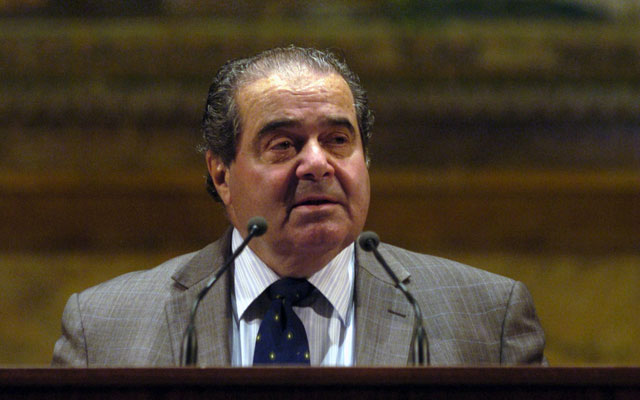The inflammatory attacks on Justice Antonin Scalia after the oral arguments in the Supreme Court in the Shelby County case last week show the desperation of the supporters of the “racial entitlement” that is Section 5 of the Voting Rights Act.
Those attacks, and some of the disgusting political cartoons about Scalia and Jim Crow circulating on the Internet, are completely unfounded. Yet these attacks actually prove the truth of what Scalia said. At least one of the reasons why Congress renewed Section 5 of the Voting Rights Act in 2006 with such a high margin was because such vicious and unfair race-baiting is common, and politicians pay a heavy price for such attacks even when they don’t deserve them.
The Daily Signal depends on the support of readers like you. Donate now
Section 5 requires certain covered jurisdictions (mostly in the South) to get the pre-approval of the federal government before they can make any changes in their voting laws. It is a temporary provision that was supposed to last only five years. In its arguments supporting the provision, the government (through Solicitor General Donald Verrilli) made much of the fact that Congress has repeatedly and overwhelmingly voted to renew it.
Justice Scalia didn’t think that overwhelming vote was “attributable to the fact that it is so much clearer now that we need this.” Instead, he thought it was attributable to “a phenomenon that is called perpetuation of racial entitlement.… Whenever a society adopts racial entitlement, it is very difficult to get out of them through the normal political processes.” As the vicious, personal attacks on Scalia show, the only thing certain about talking honestly about the current benefits and burdens of Section 5 (or voting against its renewal) is the very type of venomous attacks and false claims of racism and Jim Crow to which Scalia has been subjected.
In fact, as I have pointed out elsewhere, Section 5 has been used as a “racial entitlement” by both major political parties for similar partisan purposes. Its requirement that race be taken into account in redistricting goes against our most basic principles of equal protection and equal treatment under the law. Yet that requirement has been used by Democrats to create racially gerrymandered districts that provide black and Hispanic legislators with virtually guaranteed incumbency protection and create safe Republican seats in the surrounding areas. Thus, Section 5 has been used as a racial spoils system by both parties to protect incumbents and create more safe seats for the two major parties even if it creates an apartheid-like redistricting system that segregates voters by race.
Chief Justice Roberts has also been unfairly criticized for pointing out that one of the worst states in the country with a large disparity between black and white voter turnout (which was the very basis for Section 5) is Massachusetts, which is not one of the states covered by Section 5. One of the states with the least disparity is Mississippi, a state that should supposedly remain covered under Section 5 because it is so prone to racism. Roberts has been disparaged for asking about these facts even though they were set forth in the opinion of the dissenting judge in the federal court of appeals decision in the Shelby case and were uncontested by any of the litigants. As Ilya Shapiro at the Cato Institute has explained, this information comes from the U.S. Census Bureau, which does extensive surveys after every federal election.
In fact, the Census Bureau’s survey of the 2008 election shows that the percentage of black citizens who voted in the South was 66 percent, but it was only 58.6 percent in the Northeast. In 2004 (the last year of election information Congress had when it was voting on renewal in 2006), the Census survey reported that 58.9 percent of blacks voted in the South compared to only 56.2 percent in the Northeast.
No wonder Verrilli could not answer the Chief Justice’s question about whether it was “the government’s submission that the citizens in the South are more racist than citizens in the North?” Verrilli said “it is not, and I do not know the answer to that.”
From the arguments and the critical comments in the media, many of the supporters of Section 5 seem to believe in the legal concept of “corruption of blood,” which was outlawed by the Constitution. Apparently, the grandchildren of those who held office in the South in 1965 cannot be trusted today and are still responsible for the sins of their grandfathers. And (as outlined in the lower court decision) since the covered jurisdictions in the South today “have far more black officeholders as a proportion of the black population than do uncovered ones,” the grandsons and granddaughters of those who fought in the civil rights movement also apparently cannot be trusted today as officeholders to refrain from the type of widespread, systematic, official discrimination that Section 5 was intended to stop.
What is clear from the criticism heaped on anyone who questions the constitutionality of Section 5—which the Supreme Court recognized in 1966 as an extraordinary intrusion into state sovereignty that was justified only by the unique and dire circumstances that existed at the time—is that one of Justice Scalia’s other observations is absolutely correct: Unless the Supreme Court strikes down Section 5, “it will be reenacted in perpetuity.”































